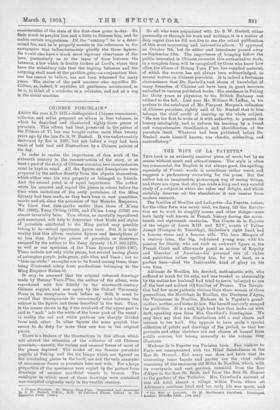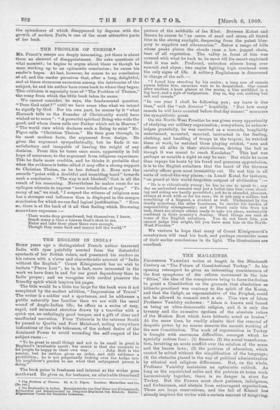THE WIFE OF L.A. FA.YETTE.*
THIS book is an evidently amateur piece of work, but by no means without merit and attractiveness. The style is often too ornamental, the English is not always good, the spelling, especially of French words, is sometimes rather weird, and suggests a perfunctory correcting for the press. But the author has an imaginative, picturesque way of seeing things, and there are signs that she has made a long and very careful study of a subject in which she takes real delight, and which certainly deserves all the elucidation it can receive from modern research.
The families of Noailles and Lafayette—La Fayette, rather, `for the other form was never used, we fancy, till the Revolu-
tion set to work to simplify names and other things—were both fairly well known in French history during the seven- teenth and eighteenth centuries. The Comte de in Fayette of the reigns of Louis XIII, and XIV., cousin of Father Joseph (Francois du Tremblay), Richelieu's right hand, had a famous sister and a famous wife. The hero Marquis of a. century later, the big, red-haired young man with his passion for liberty, who cut such an awkward figure at the French Court and afterwards posed as saviour of Royalty and liberator of America—his personal airs of virtue and patriotism rather spoiling him, for us at least, as a perfect hero—shed the fashionable kind of glory on his own time.
Adrienne de Noailles, his devoted, enthusiastic wife, who suffered so much for his sake, and was treated so abominably by the nation her husband had tried to serve, belonged to one of the best and noblest old families of France. The Revolu- tion had few more pathetic victims than those women of three generations, the Marechale de Noailles, the Duchesee d'Ayen, the Vicomtesse de Noailles, Madame de in Fayette's grand- mother, mother, and sister-in-law. She herself narrowly escaped the guillotine. It is a sad, high-bred face that looks out with dark, speaking eyes from Mrs. Crawford's frontispiece. We may here say that the illustrations add a real charm and interest to her book. She appears to have made a special collection of prints and drawings of the period, so that her portraits and other sketches are not chosen at hazard from public sources, but belong naturally to the volume they illustrate.
Madame de In Fayette was Parisian born. Few visitors to Paris are unacquainted with the Hotel Saint-James in the Rue St. Honore. But every one does not know that its interesting inner facade and garden are the chief relics remaining of the enormous old Hotel de Noailles, which, with its courtyards and vast gardens, extended from the Rue d'Alger to the Rue St. Hoch, and from the Rue St. Honors
to the gardens of the Tuileries. Mrs. Crawford's account of this old hotel, almost a village within Paris, where all Adrienne's relations lived and her early life was spent, and * rite Wife of Lafayette. By 35. AtacDorrnot Crawford, illustrated. London: Evolver& Nash, [lt,s. ad.]
the splendours of which disappeared by degrees with the growth of modern Paris, is one of the most attractive parts of her book.















































 Previous page
Previous page